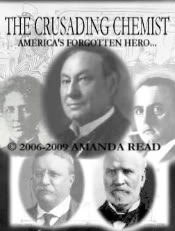The Screenplay
I’ve learned so much in the way of history and screenwriting since the first revision that I think it is in dire need of another revision! But this is how my first round of research left things…
NEWS: The 1st Revision has been uploaded.
Click the below links to read…
or
(Original Draft) 1st Edition of THE CRUSADING CHEMIST
The Crusading Chemist is a 129 page screenplay by Amanda Read that took two years to
complete. It is written as a historical drama for the screen which overall covers time periods
from 1882 to 1926. It also features the settings spanning from Indiana, Washington, D.C.,
Missouri, Colorado, and France.
~ ~ ~
A STORY OF A FORGOTTEN HERO
As many of you probably well know, much of the food that is manufactured, sold and
consumed in our country is adulterated and leeched of the essential nutrients that our
ancestors used to have access to. That is why there is such a strong emphasis on taking
vitamins and finding organic whole foods in our modern day and age. But where did that
ridiculous controversy start in the first place? Why isn’t everything at the store natural and
wholesome like it should be? Why should we even have to worry about it?
Just a little over one hundred years ago, American citizens were outraged over such
products. Back then additives, preservatives, bleached flour, etc. were freak practices of
careless businessmen that were fast becoming vogue. Harvey Wiley, once just a farmer boy
from Indiana (the 6th of 7 children as a matter of fact!) and eventually early 20th century
America’s most famous chemist, decided that something must be done about it. {Allow me
to lapse into present tense here, as drama goes} His crusade for a law banning such
practices (known as the Pure Food and Drug Law) is opposed only by two main forces that
are deeply personified in two actual historical characters: Walter Williams, a fiercely
antagonistic businessmen that is ambitious to have a profitable industry no matter what
practice – and is later sorely penitent – and Solicitor McCabe, a suave young lawyer
ambitious to become the most powerful legal official in the USDA that has grudgingly
observed Harvey’s success. McCabe influences the well-meaning but wavering Secretary of
Agriculture (the Scottish-born James Wilson) to appoint opposing scientists to counteract
the enforcement of the Pure Food and Drug Law in one of the most misunderstood and
ignored crimes in American government.
A STORY OF SCIENCE AND POLITICS
As I began doing research on the historical setting, I realized that this story (though perhaps
boring at first glance) is a goldmine of poignant themes. One of my favorite elements that I
chose to elaborate on is that of science. The protagonist (Harvey Wiley) lives through the
most shocking era of change in scientific history. One thing that struck me most about the
era of the late 19th century and early 20th century is that it became somewhat of a “second
Renaissance” – a time of “enlightenment” amongst scientists, businessmen and politicians that
steered the modern world towards humanism.
The script illustrates the faulty thinking that comes as a result of putting too much trust in
science and politics – and what happens when our leaders allow elitism to have its way.
A STORY OF AN UNUSUAL ROMANCE
Well, romance is almost stereotypical in every genre of film, but this history happened to
have a very unusual sort of spin on that theme. Harvey Wiley composed a humorous
chemistry poem about his “Ideal Woman” while in a laboratory at Harvard University when
he was around 30 years old. However, he soon became so absorbed in his work and
research that for many years he didn’t even consider marriage an option in his busy life. In
fact, he didn’t even meet his “Ideal Woman” until he was 54 years old – and she was 33
years younger! Miss Anna Kelton briefly did secretarial work in the Bureau of Chemistry and
then took a position at the Library of Congress. Harvey and Anna barely saw each other
during the tumultuous decade of the Pure Food and Drug Law’s passage, but they had
impacted each other’s lives greatly and both had passion for the cause. When Harvey was 66
years old he proposed to her and she accepted. They married a year later and eventually had
two sons.
PULLING IT ALL TOGETHER
The bulk of the literary work in a screenplay is dialogue. For this script, I was blessed to be
provided with loads of transcripts, Congressional records and writings by direct witnesses
as to what these people actually said and did. Some of my favorite scenes took place straight
out of Harvey Wiley’s autobiography and New York Times archives! Of course, there are
many scenes that I had to edit or invent dialogue for and quite a few scenes that I had to
completely fabricate.
To find out more, read the Treatment.

Be First to Comment